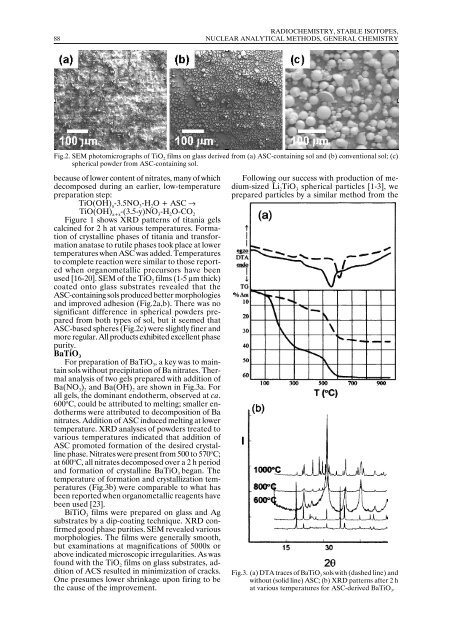annual report annual report annual report annual report 2005
annual report annual report annual report annual report 2005
annual report annual report annual report annual report 2005
You also want an ePaper? Increase the reach of your titles
YUMPU automatically turns print PDFs into web optimized ePapers that Google loves.
88<br />
RADIOCHEMISTRY, STABLE ISOTOPES,<br />
NUCLEAR ANALYTICAL METHODS, GENERAL CHEMISTRY<br />
Fig.2. SEM photomicrographs of TiO 2 films on glass derived from (a) ASC-containing sol and (b) conventional sol; (c)<br />
spherical powder from ASC-containing sol.<br />
because of lower content of nitrates, many of which<br />
decomposed during an earlier, low-temperature<br />
preparation step:<br />
TiO(OH) a -3.5NO 3 -H 2 O + ASC →<br />
TiO(OH) a+x<br />
-(3.5-y)NO 3<br />
-H 2<br />
O-CO 2<br />
Figure 1 shows XRD patterns of titania gels<br />
calcined for 2 h at various temperatures. Formation<br />
of crystalline phases of titania and transformation<br />
anatase to rutile phases took place at lower<br />
temperatures when ASC was added. Temperatures<br />
to complete reaction were similar to those <strong>report</strong>ed<br />
when organometallic precursors have been<br />
used [16-20]. SEM of the TiO 2 films (1-5 µm thick)<br />
coated onto glass substrates revealed that the<br />
ASC-containing sols produced better morphologies<br />
and improved adhesion (Fig.2a,b). There was no<br />
significant difference in spherical powders prepared<br />
from both types of sol, but it seemed that<br />
ASC-based spheres (Fig.2c) were slightly finer and<br />
more regular. All products exhibited excellent phase<br />
purity.<br />
BaTiO 3<br />
For preparation of BaTiO 3 , a key was to maintain<br />
sols without precipitation of Ba nitrates. Thermal<br />
analysis of two gels prepared with addition of<br />
Ba(NO 3 ) 2 and Ba(OH) 2 are shown in Fig.3a. For<br />
all gels, the dominant endotherm, observed at ca.<br />
600 o C, could be attributed to melting; smaller endotherms<br />
were attributed to decomposition of Ba<br />
nitrates. Addition of ASC induced melting at lower<br />
temperature. XRD analyses of powders treated to<br />
various temperatures indicated that addition of<br />
ASC promoted formation of the desired crystalline<br />
phase. Nitrates were present from 500 to 570 o C;<br />
at 600 o C, all nitrates decomposed over a 2 h period<br />
and formation of crystalline BaTiO 3 began. The<br />
temperature of formation and crystallization temperatures<br />
(Fig.3b) were comparable to what has<br />
been <strong>report</strong>ed when organometallic reagents have<br />
been used [23].<br />
BiTiO 3 films were prepared on glass and Ag<br />
substrates by a dip-coating technique. XRD confirmed<br />
good phase purities. SEM revealed various<br />
morphologies. The films were generally smooth,<br />
but examinations at magnifications of 5000x or<br />
above indicated microscopic irregularities. As was<br />
found with the TiO 2 films on glass substrates, addition<br />
of ACS resulted in minimization of cracks.<br />
One presumes lower shrinkage upon firing to be<br />
the cause of the improvement.<br />
Following our success with production of medium-sized<br />
Li 2<br />
TiO 3<br />
spherical particles [1-3], we<br />
prepared particles by a similar method from the<br />
Fig.3. (a) DTA traces of BaTiO 3<br />
sols with (dashed line) and<br />
without (solid line) ASC; (b) XRD patterns after 2 h<br />
at various temperatures for ASC-derived BaTiO 3 .
















